Experiencing the Untouchable: A Method for Scientific Exploration and Haptic Fruition of Artworks Microsurface Based on Optical Scanning Profilometry
Abstract
:1. Introduction and Background
- The artwork surface holds a lot of geometric information, being a superimposition of a large number of spatial wavelengths and having an intrinsic multiscale nature, from shape to local texture;
- The emerging role of 3D survey and 3D printing in heritage applications [13].
- To demonstrate a workflow for tactile fruition of multiscale and polychrome artworks based on the acquisition of microgeometry and 3D printing technology;
- To validate the use of conoscopic holography sensors for high-quality acquisition of the surface dataset, up to the microscale, suitable for 3D printing.
- To demonstrate the potential of the tool not only for tactile fruition of artworks but also as an innovative resource for scientific “visualization” in conservation science.
2. Materials and Methods
2.1. Optical Scanning Microprofilometry
2.2. Proof of Concept Case Studies
- (1)
- Scientific fruition of paintings
- (a)
- Microsurface exploration for conservation scientists through 3D printing technology.Case study: oil painting on canvas by Tintoretto “St. Martial in Glory with the Saints Peter and Paul” in Venice;The specific aim is to optimize the signals without distorting the surfaces, turning them into “real objects” suitable to touch, thus providing a novel fruition tool for insiders.
- (b)
- Meaningful acquisition of a polychrome ancient painting in order to provide different ways of visualization and exploration of the microsurface information.Case study: eighteenth-century painting from private collection.The importance of this case lies in the information captured by the microprofilometer: both the heights map and the reflectance values are explored.
- (2)
- In situ high-quality data acquisition in order to obtain accurate 3D printed replicas.Case study: “Dead Christ” bronze relief of the Donatello’s High Altar in the “Basilica del Santo” in Padua;This relief is an exemplar case study because it has multiscale surface features including main shapes (centimeters) with finer details (submillimeter) and the bronze texture (micrometers).
- (3)
- Acquisition of painted figures on a 3D shape in order to process an enhanced replica that enables tactile exploration for visually impaired people.Case study: Apulian red-figure pelike (375–350 BC) exhibited at the Museum of Archaeological Sciences and Art in Padua;The technical importance of the case study is concerned with the acquisition of the macroscopic 3D shape and the microscale texture that encodes the figures represented on the vase, and their processing bearing in mind the haptic fruition.
3. Results and Discussion
3.1. Scientific Fruition of Paintings
3.1.1. Microsurface Exploration for Conservation Science: St. Martial in Glory with the Saints Peter and Paul by Tintoretto
3.1.2. High Precision Microgeometries Acquisition and Exploration: Polychrome Eighteenth-Century Painting
3.2. High-Quality 3D Printed Replica: Donatello’s Dead Christ Bronze Relief
3.3. Tactile Exploration of Painted Figures for Visually Impaired People: Apulian Red-Figure Pelike
4. Conclusions
Author Contributions
Funding
Institutional Review Board Statement
Informed Consent Statement
Data Availability Statement
Acknowledgments
Conflicts of Interest
Abbreviations
| SNR | Signal-to-Noise Ratio |
| ROI | Region Of Interest |
| ADF | Amplitude Distribution Function |
| PSD | Power Spectral Density |
| SLA | Stereolithography Apparatus |
References
- Arnheim, R. Art and Visual Perception, Second Edition: A Psychology of the Creative Eye; University of California Press: Berkeley, CA, USA, 2004. [Google Scholar]
- Vandivere, A.; van Loon, A.; Dooley, K.A.; Haswell, R.; Erdmann, R.G.; Leonhardt, E.; Delaney, J.K. Revealing the painterly technique beneath the surface of Vermeer’s Girl with a Pearl Earring using macro- and microscale imaging. Herit. Sci. 2019, 7, 64. [Google Scholar] [CrossRef] [Green Version]
- Palma, G.; Pingi, P.; Siotto, E.; Bellucci, R.; Guidi, G.; Scopigno, R. Deformation analysis of Leonardo da Vinci’s “Adorazione dei Magi” through temporal unrelated 3D digitization. J. Cult. Herit. 2019, 38, 174–185. [Google Scholar] [CrossRef]
- Tornari, V. Laser interference-based techniques and applications in structural inspection of works of art. Anal. Bioanal. Chem. 2007, 387, 761–780. [Google Scholar] [CrossRef]
- Striova, J.; Fontana, R.; Barucci, M.; Felici, A.; Marconi, E.; Pampaloni, E.; Raffaelli, M.; Riminesi, C. Optical devices provide unprecedented insights into the laser cleaning of calcium oxalate layers. Microchem. J. 2016, 124, 331–337. [Google Scholar] [CrossRef]
- Marchioro, G.; Perlini, L.; Daffara, C. Monitoring microclimate-induced deformations on hygroscopic materials using conoscopic holography sensors. Proc. SPIE 2019, 11058, 1105812. [Google Scholar] [CrossRef]
- Martin, M. Sight and touch. In The Contents of Experience: Essays on Perception; Crane, T., Ed.; Cambridge University Press: Cambridge, UK, 1992; pp. 196–215. [Google Scholar] [CrossRef]
- Hutmacher, F. Why Is There So Much More Research on Vision Than on Any Other Sensory Modality? Front. Psychol. 2019, 10, 2246. [Google Scholar] [CrossRef]
- Fontana, R.; Gambino, M.C.; Mazzotta, C.; Greco, M.; Pampaloni, E.; Pezzati, L. High-resolution 3D survey of artworks. Proc. SPIE 2004, 5457, 719–726. [Google Scholar] [CrossRef]
- Carcagni, P.; Daffara, C.; Fontana, R.; Gambino, M.C.; Mastroianni, M.; Mazzotta, C.; Pampaloni, E.; Pezzati, L. Optical micro-profilometry for archaeology. Proc. SPIE 2005, 5857, 58570F. [Google Scholar] [CrossRef]
- Bergmann Tiest, W.M. Tactual perception of material properties. Vis. Res. 2010, 50, 2775–2782. [Google Scholar] [CrossRef] [PubMed] [Green Version]
- Skedung, L.; Arvidsson, M.; Chung, J.Y.; Stafford, C.M.; Berglund, B.; Rutland, M.W. Feeling Small: Exploring the Tactile Perception Limits. Sci. Rep. 2013, 3, 2617. [Google Scholar] [CrossRef] [Green Version]
- Balletti, C.; Ballarin, M. An Application of Integrated 3D Technologies for Replicas in Cultural Heritage. ISPRS Int. J. Geo-Inf. 2019, 8, 285. [Google Scholar] [CrossRef] [Green Version]
- Sahli, R.; Prot, A.; Wang, A.; Müser, M.H.; Piovarči, M.; Didyk, P.; Bennewitz, R. Tactile perception of randomly rough surfaces. Sci. Rep. 2020, 10, 15800. [Google Scholar] [CrossRef] [PubMed]
- Volpe, Y.; Furferi, R.; Governi, L.; Tennirelli, G. Computer-based methodologies for semi-automatic 3D model generation from paintings. Int. J. Comput. Aided Eng. Technol. 2014, 6, 88–112. [Google Scholar] [CrossRef]
- Carfagni, M.; Furferi, R.; Governi, L.; Volpe, Y.; Tennirelli, G. Tactile Representation of Paintings: An Early Assessment of Possible Computer Based Strategies. In Progress in Cultural Heritage Preservation; Ioannides, M., Fritsch, D., Leissner, J., Davies, R., Remondino, F., Caffo, R., Eds.; Springer: Berlin/Heidelberg, Germany, 2012; pp. 261–270. [Google Scholar]
- Krivec, T.; Muck, T.; Germadnik, R.F.; Majnarić, I.; Golob, G. Adapting Artworks for People who Are Blind or Visually Impaired Using Raised Printing. J. Vis. Impair. Blind. 2014, 108, 68–76. [Google Scholar] [CrossRef] [Green Version]
- Reichinger, A.; Maierhofer, S.; Purgathofer, W. High-Quality Tactile Paintings. J. Comput. Cult. Herit. 2011, 4. [Google Scholar] [CrossRef]
- Buonamici, F.; Carfagni, M.; Furferi, R.; Governi, L.; Volpe, Y. Are We Ready to Build a System for Assisting Blind People in Tactile Exploration of Bas-Reliefs? Sensors 2016, 16, 1361. [Google Scholar] [CrossRef] [PubMed] [Green Version]
- Remondino, F.; Rizzi, A.; Barazzetti, L.; Scaioni, M.; Fassi, F.; Brumana, R.; Pelagotti, A. Review of Geometric and Radiometric Analyses of Paintings. Photogramm. Rec. 2011, 26, 439–461. [Google Scholar] [CrossRef]
- Abate, D. Documentation of paintings restoration through photogrammetry and change detection algorithms. Herit. Sci. 2019, 7, 13. [Google Scholar] [CrossRef] [Green Version]
- Sánchez-Jiménez, D.; Buchón-Moragues, F.; Bravo, J.M.; Sánchez-Pérez, J.V. Estimation of the Precision of a Structured Light System in Oil Paintings on Canvas. Sensors 2019, 19, 4966. [Google Scholar] [CrossRef] [Green Version]
- Pelagotti, A.; Uccheddu, F.; Massa, E.; Carfagni, M. Comparing two 3D measurement techniques for documenting painted wooden panels surface deformations on a real test case: “Mystical Marriage of Saint Catherine” by Renaissance artist Piero di Cosimo. IOP Conf. Ser. Mater. Sci. Eng. 2018, 364, 012090. [Google Scholar] [CrossRef] [Green Version]
- Elkhuizen, W.S.; Callewaert, T.W.J.; Leonhardt, E.; Vandivere, A.; Song, Y.; Pont, S.C.; Geraedts, J.M.P.; Dik, J. Comparison of three 3D scanning techniques for paintings, as applied to Vermeer’s ‘Girl with a Pearl Earring’. Herit. Sci. 2019, 7, 89. [Google Scholar] [CrossRef]
- Manfredi, M.; Bearman, G.; Williamson, G.; Kronkright, D.; Doehne, E.; Jacobs, M.; Marengo, E. A New Quantitative Method for the Non-Invasive Documentation of Morphological Damage in Paintings Using RTI Surface Normals. Sensors 2014, 14, 12271–12284. [Google Scholar] [CrossRef] [Green Version]
- Gaburro, N.; Marchioro, G.; Daffara, C. A versatile optical profilometer based on conoscopic holography sensors for acquisition of specular and diffusive surfaces in artworks. Proc. SPIE 2017, 10331, 48–56. [Google Scholar] [CrossRef]
- Marchioro, G.; Apostolidis, G.; Karagiannis, G.; Galeotti, M.; Daffara, C. Surface and subsurface layers characterization in artworks using conoscopic laser holography and acoustic microscopy. Proc. SPIE 2017, 10331, 103310L. [Google Scholar]
- Gaburro, N.; Marchioro, G.; Daffara, C. Conoscopic laser microprofilometry for 3D digital reconstruction of surfaces with sub-millimeter resolution. In Proceedings of the 2017 IEEE International Conference on Environment and Electrical Engineering and 2017 IEEE Industrial and Commercial Power Systems Europe (EEEIC/I CPS Europe), Milan, Italy, 6–9 June 2017; pp. 1–4. [Google Scholar] [CrossRef]
- Callieri, M.; Pingi, P.; Potenziani, M.; Dellepiane, M.; Pavoni, G.; Lureau, A.; Scopigno, R. Alchemy in 3D: A digitization for a journey through matter. In Proceedings of the 2015 Digital Heritage, Granada, Spain, 28 September–2 October 2015; Volume 1, pp. 223–230. [Google Scholar] [CrossRef]
- Visual Computing Laboratory, ISTI CNR, Italy. Jackson Pollock. Alchemy in 3D. Available online: http://vcg.isti.cnr.it/alchemy/ (accessed on 23 March 2012).
- Balletti, C.; Ballarin, M.; Guerra, F. 3D printing: State of the art and future perspectives. J. Cult. Herit. 2017, 26, 172–182. [Google Scholar] [CrossRef]
- Bates, W. A wavefront shearing interferometer. Proc. Phys. Soc. 1947, 59, 940. [Google Scholar] [CrossRef]
- Pancharatnam, S. Generalized theory of interference and its applications. In Proceedings of the Indian Academy of Sciences-Section A; Springer: Berlin/Heidelberg, Germany, 1956; Volume 44, pp. 398–417. [Google Scholar]
- Sirat, G.Y.; Paz, F.; Kleinman, M.; Doherty, M. ConoProbe and ConoLine: Two new three-dimensional measurement systems. In Proceedings of the Third International Symposium on Laser Precision Microfabrication, Osaka, Japan, 27–31 May 2002; International Society for Optics and Photonics: Bellingham, WA, USA, 2003; Volume 4830, pp. 319–324. [Google Scholar]
- Marchioro, G. A Framework for Surface Metrology on Cultural Heritage Objects Based on Scanning Conoscopic Holography. Ph.D. Thesis, University of Verona, Verona, Italy, 2021. [Google Scholar]
- Fernández, P.; Blanco, D.; Rico, C.; Valiño, G.; Mateos, S. Influence of Surface Position along the Working Range of Conoscopic Holography Sensors on Dimensional Verification of AISI 316 Wire EDM Machined Surfaces. Sensors 2014, 14, 4495–4512. [Google Scholar] [CrossRef] [Green Version]
- Brunetto, A.; Bono, G.; Frezzato, F. Er:YAG laser cleaning of ‘San Marziale in Gloria’ by Jacopo Tintoretto in the Church of San Marziale, Venice. J. Inst. Conserv. 2020, 43, 44–58. [Google Scholar] [CrossRef]
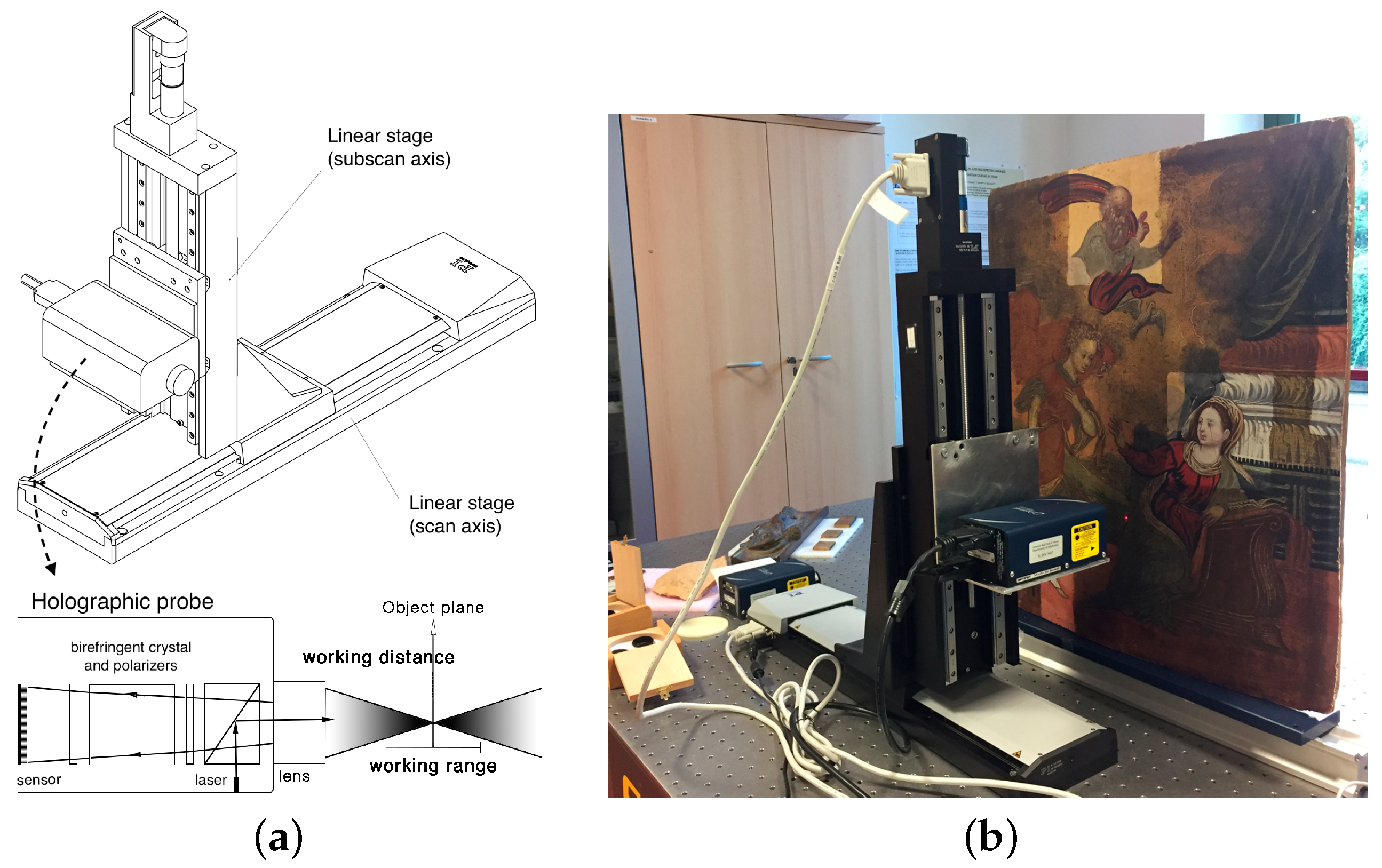


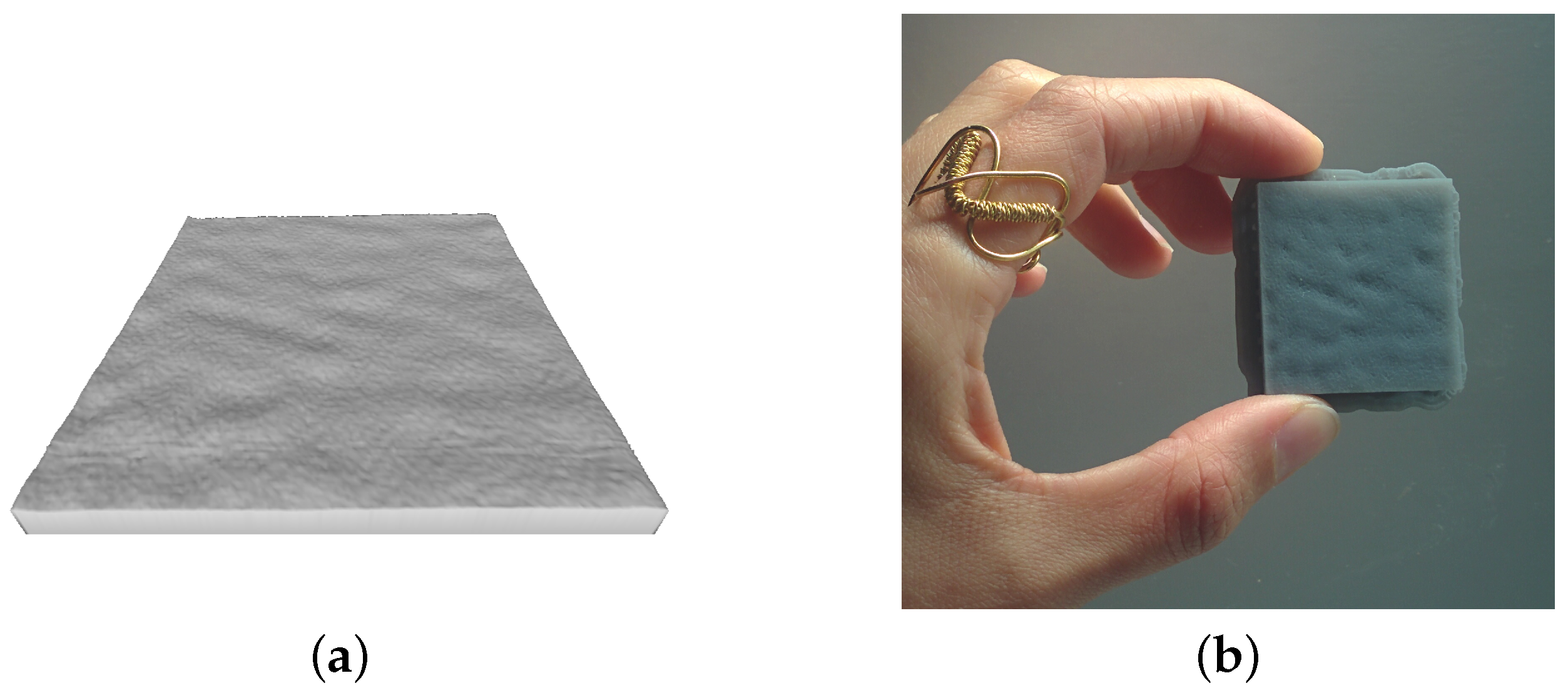


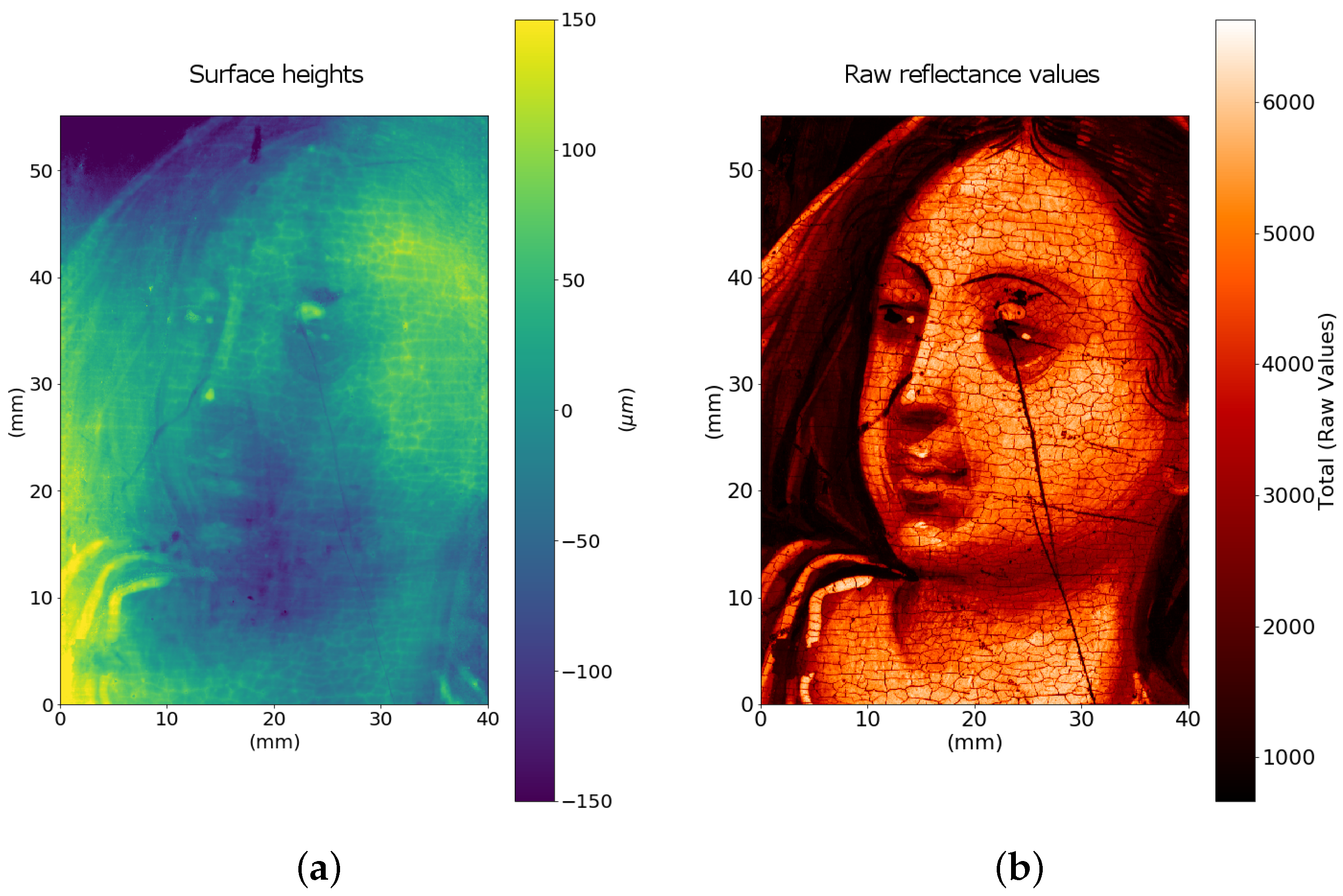

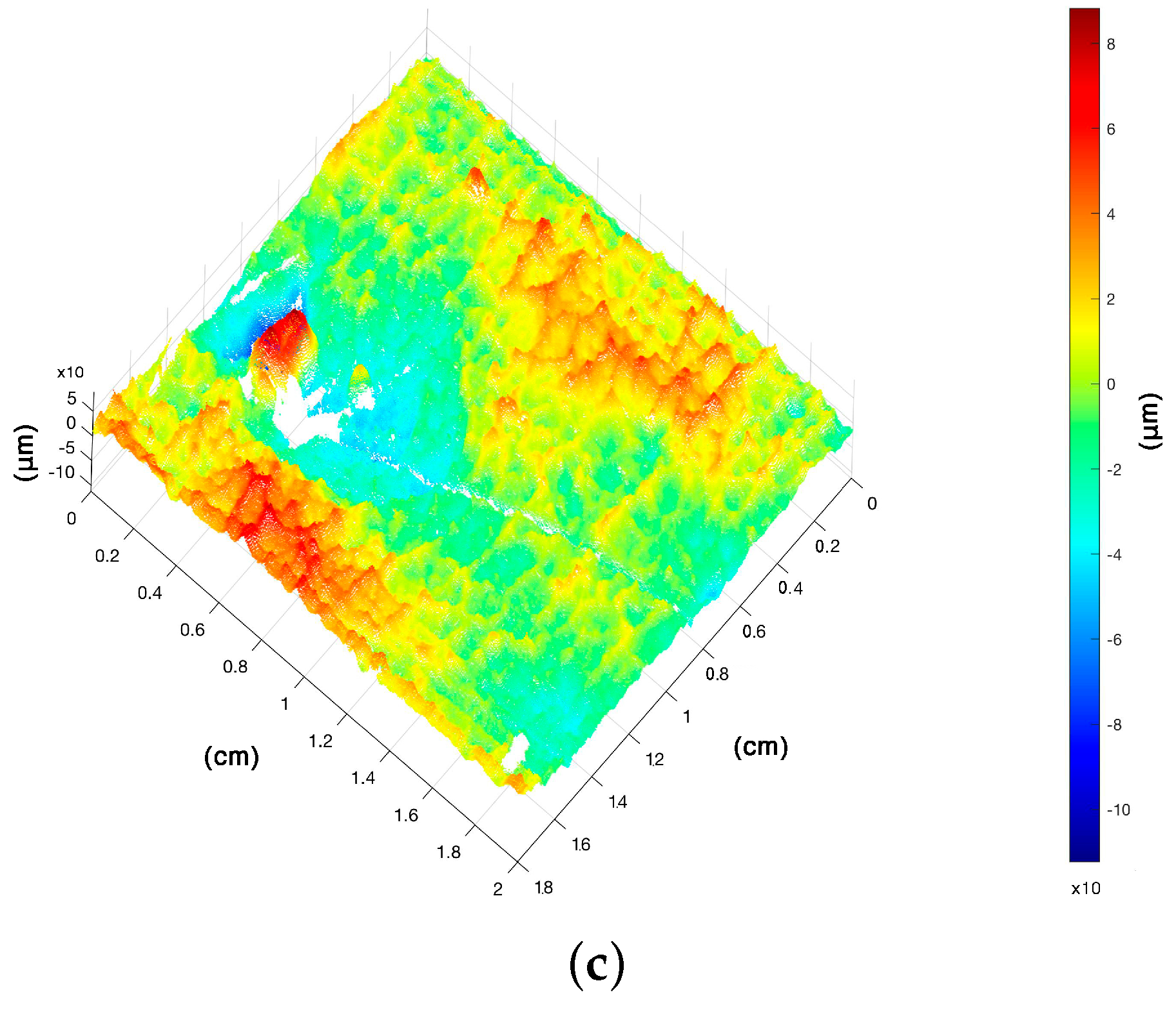
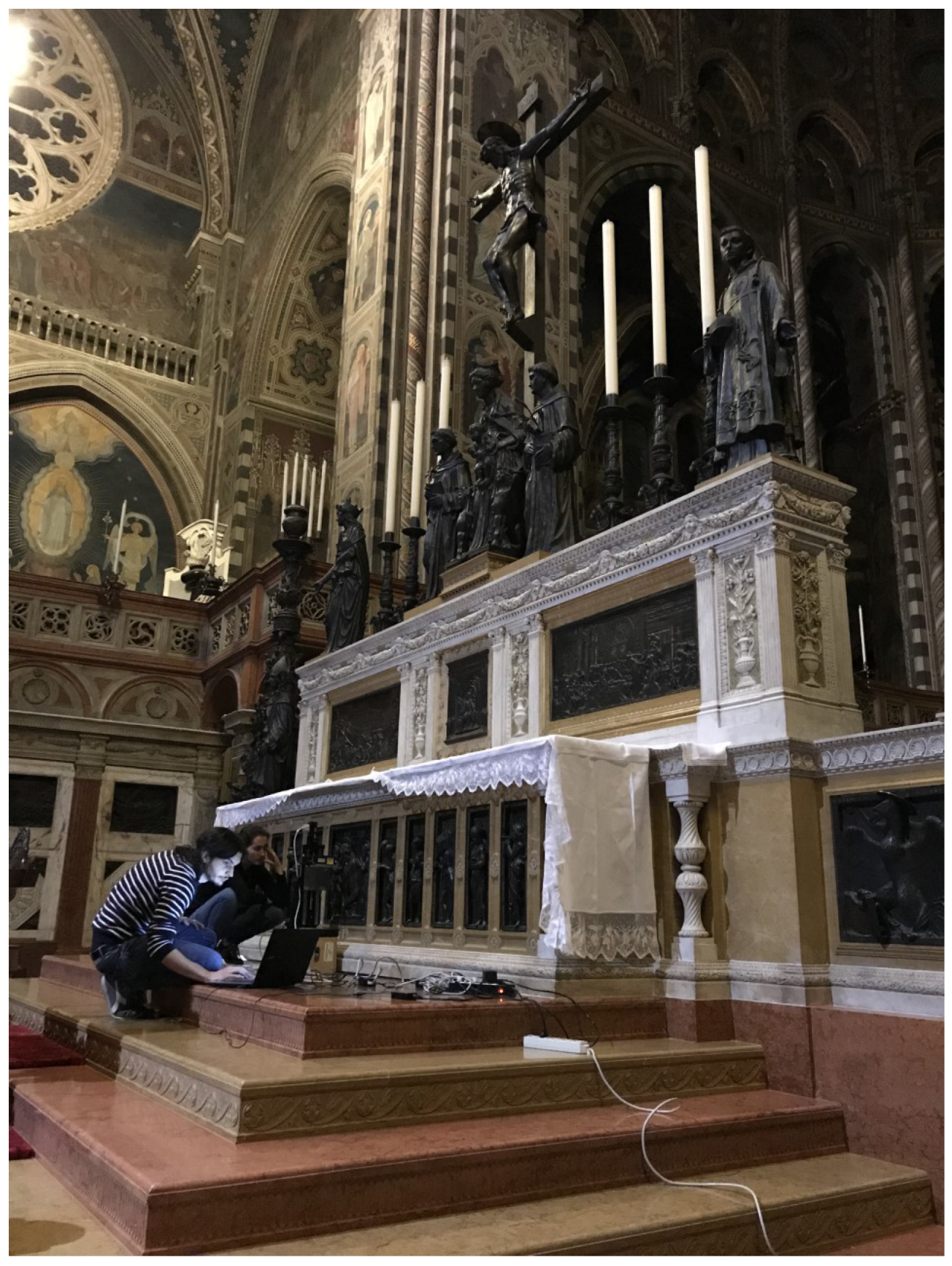


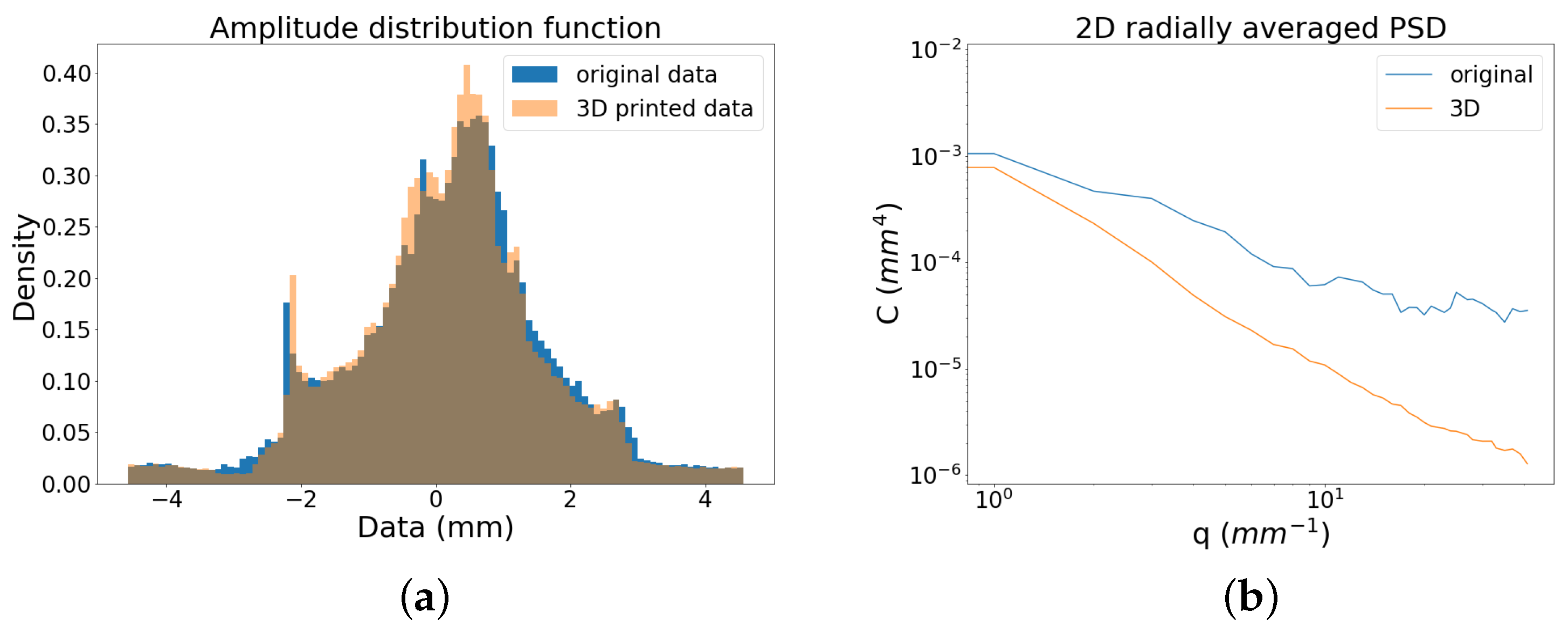
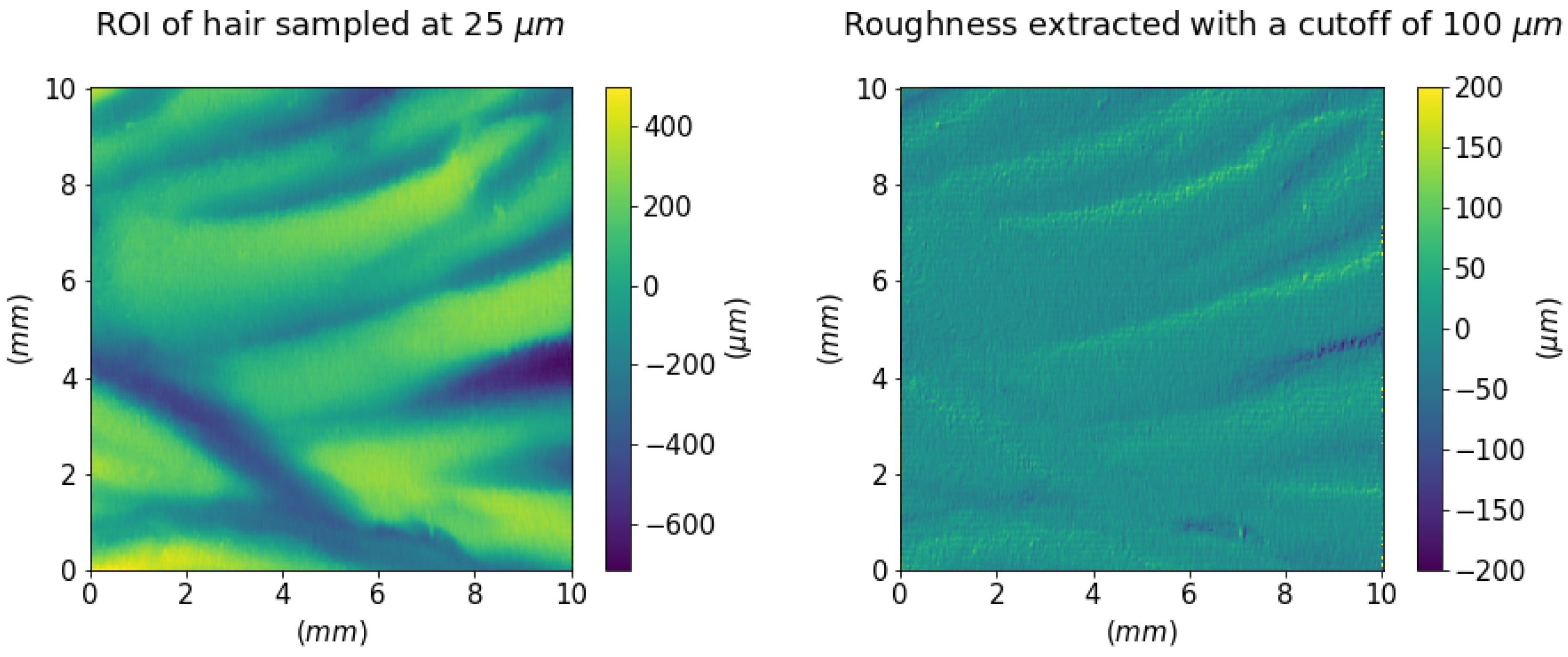
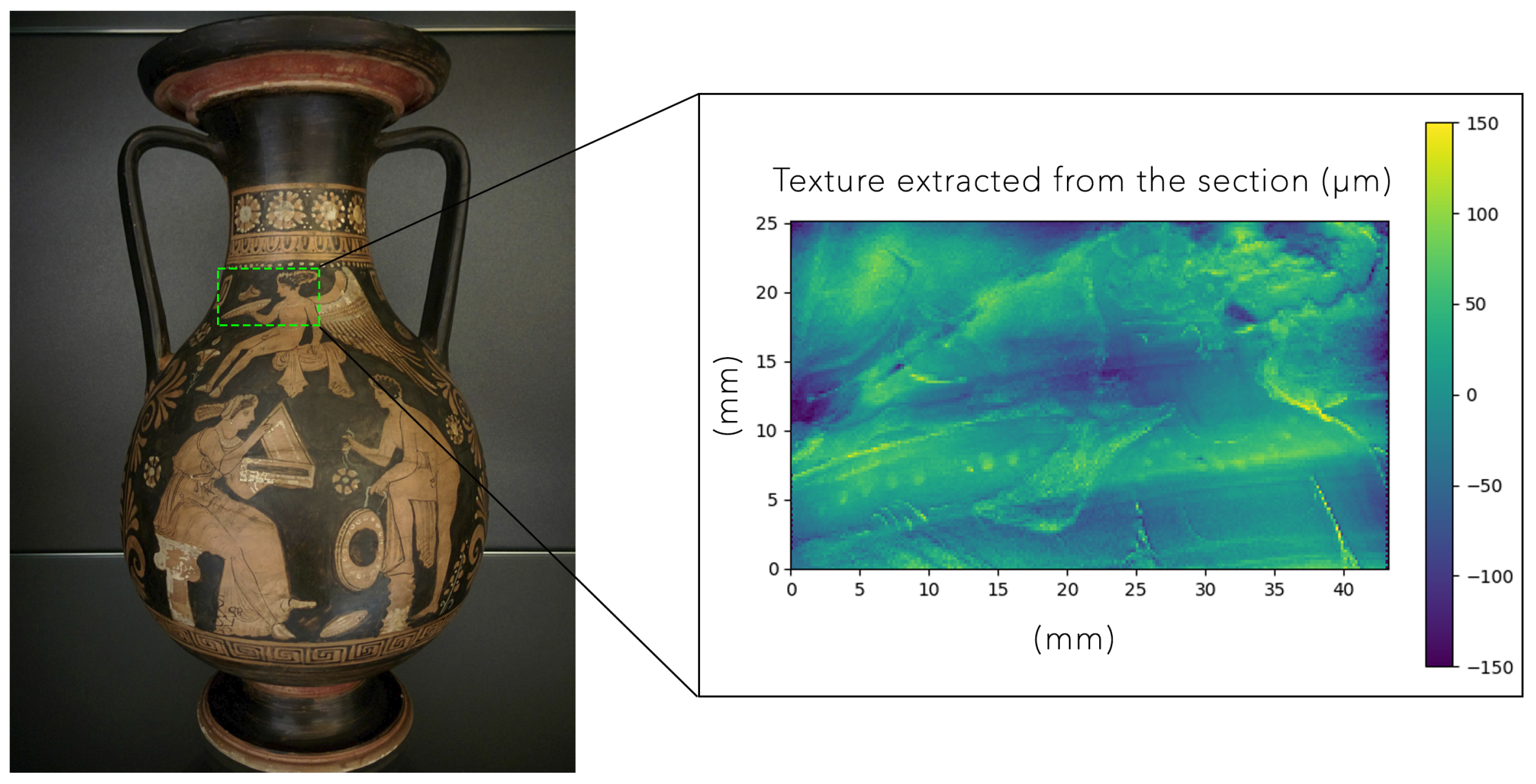

| Case Study | Probe | Lens | Stand-Off Distance | Working Range | Accuracy | Laser Spot | |
|---|---|---|---|---|---|---|---|
| (mm) | (mm) | (μm) | (μm) | ||||
| 1 (a) | Painting | ConoPoint-3 | 100 mm | 95 | 35 | 15 | 63 |
| (in situ) | |||||||
| 1 (b) | Painting | ConoPoint-3HD | 50 mm | 42 | 2 | 2.5 | 19 |
| (lab) | |||||||
| 2, 3 | 3D shape | ConoPoint-3 | 75 mm | 70 | 18 | 10 | 47 |
| (in situ) | |||||||
Publisher’s Note: MDPI stays neutral with regard to jurisdictional claims in published maps and institutional affiliations. |
© 2021 by the authors. Licensee MDPI, Basel, Switzerland. This article is an open access article distributed under the terms and conditions of the Creative Commons Attribution (CC BY) license (https://creativecommons.org/licenses/by/4.0/).
Share and Cite
Mazzocato, S.; Daffara, C. Experiencing the Untouchable: A Method for Scientific Exploration and Haptic Fruition of Artworks Microsurface Based on Optical Scanning Profilometry. Sensors 2021, 21, 4311. https://doi.org/10.3390/s21134311
Mazzocato S, Daffara C. Experiencing the Untouchable: A Method for Scientific Exploration and Haptic Fruition of Artworks Microsurface Based on Optical Scanning Profilometry. Sensors. 2021; 21(13):4311. https://doi.org/10.3390/s21134311
Chicago/Turabian StyleMazzocato, Sara, and Claudia Daffara. 2021. "Experiencing the Untouchable: A Method for Scientific Exploration and Haptic Fruition of Artworks Microsurface Based on Optical Scanning Profilometry" Sensors 21, no. 13: 4311. https://doi.org/10.3390/s21134311






